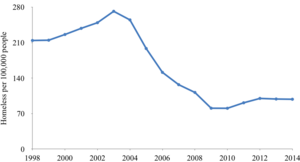
In England, local authorities have duties to homeless people under Part VII of the Housing Act 1996 as amended by the Homelessness Act 2002. There are five hurdles which a homeless person must overcome in order to qualify as statutory homeless. If an applicant only meets the first three of these tests Councils still have a duty to provide interim accommodation. However an applicant must satisfy all five for a Council to have to give an applicant "reasonable preference" on the social housing register.[1] Even if a person passes these five tests councils have the ability to use the private rented sector to end their duty to a homeless person.[2]
The five tests are:
- Is the applicant homeless or threatened with homelessness?
- Is the applicant eligible for assistance?
- Is the applicant priority need?
- Is the applicant intentionally homeless?
- Does the applicant have a local connection?
The annual number of homeless households in England peaked in 2003–04 at 135,420 before falling to a low of 40,020 in 2009–10. In 2014–15, there were 54,430 homeless households, which was 60 per cent below the 2003–04 peak.[3] However, in December 2016 the housing charity Shelter estimated homelessness in England to amount to more than 250,000 people; Shelter calculated the figure using four sets of official sources: statistics on rough sleepers (i.e. people sleeping on the streets), statistics on those in temporary accommodation, the number of people housed in hostels and the number of people waiting to be housed by council social services departments.[4]
In England, it had been estimated in 2007 an average of 498 people slept rough each night, with 248 of those in London.[5] But reportedly numbers sleeping rough have soared in recent years and doubled since 2010; figures reported for the 2015 count were 3,569 people rough sleeping in England on a single night, up 102% from 2010.[6]
Given the costs of providing temporary accommodation and the limited amount of social housing in the United Kingdom some Councils have been criticised for attempting to circumvent their duties under the law, a process which has been termed "gatekeeping". The term "Non-statutory homelessness" covers people who are considered by the local authority to be not eligible for assistance, not in priority need or "intentionally homeless".[7][8]
Households in temporary accommodation rose from 35,850 in 2011 to 54,280 in early 2017. Part of the cause is people losing private tenancies, which Shelter maintains increased drastically since 2011 when housing benefit cuts began.[9] Almost three quarters of homeless people are single parent families. Just under 30,000 single parent families became homeless in 2017, this rose 8% from five years previously. Their limited income makes it hard for them to deal with rising living costs, high rents and benefit cuts. The number of households in temporary accommodation has risen by almost two thirds since 2010 and reached 78,930.[10] Mothers of single parent families are particularly at risk of homelessness. According to Shelter one in 55 single parent families became homeless in 2017 to 2018 and 92% of the 26,610 cases were headed by a mother.[11] In 2023, the number of homeless people in England hit record levels, with 104,510 people in England in temporary accommodation.[12] An estimated 3,898 people slept rough in England in 2023, over double the estimated figure from 2010.[13]
- ^ "Priority for council housing". England.shelter.org.uk. 5 October 2016.
- ^ "Homeless forced into private rented sector | News | Inside Housing". Archived from the original on 26 April 2016. Retrieved 7 April 2016.
- ^ "Statutory Homelessness: April to June Quarter 2015" (PDF).
- ^ Richardson, Hannah (1 December 2016). "More than 250,000 are homeless in England - Shelter". No. BBC News From the section Education & Family. BBC News. Education and social affairs reporter. Retrieved 5 December 2016.
- ^ "Homelessness Statistics September 2007 and Rough Sleeping – 10 Years on from the Target" Archived 1 October 2007 at the UK Government Web Archive September 2007 Department for Communities and Local Government: London
- ^ McVeigh, Tracy (4 December 2016). "Growing crisis on UK streets as rough sleeper numbers soar". The Observer. Retrieved 5 December 2016.
- ^ "About homelessness". Homeless Link. Archived from the original on 3 April 2020. Retrieved 19 December 2012.
- ^ "The homeless people - a priority need?". July 2015. Retrieved 1 July 2015.
- ^ "One in 25 people homeless in England's worst hit areas". BBC News. 8 November 2017.
- ^ "Almost 30,000 lone parent families made homeless in England in 2017". BBC News. 24 March 2018.
- ^ "Single mothers 'hit hard by homelessness'". BBC News. 10 October 2018.
- ^ Cite error: The named reference
The Conversationwas invoked but never defined (see the help page). - ^ Cite error: The named reference
The Guardian, February 2024was invoked but never defined (see the help page).